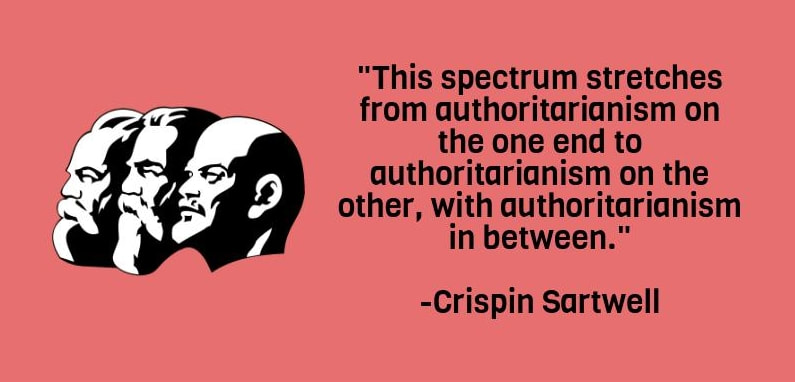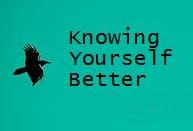Except that the left-right spectrum is really a false dichotomy that renders the positions of both "sides," contradictory, while helping to control public debate. There are serious problems with the left-right spectrum as framework for understanding politics. A critical look reveals that the spectrum is incomplete, incoherent, leads to unnecessary polarization, and reinforces belief in hierarchy.
We need to confront the fact that the positions of both "sides," are riddled with contradictions. On this extremely flawed basis, people attack the so-called other side as though politics were some kind of team sport. In order to end such narrow and destructive partisanism, let's start thinking about whether the left-right spectrum is accurate rather than just assuming it is. (Hint: it's not, as we will see).
What's Wrong With the Left-Right Political Spectrum?
The typical left-right spectrum consists of Marxism/authoritarian communism on the far left, and fascism on the far right, with liberal democracy in the middle. Every other position is reduced to a more moderate form of the aforementioned extremes along the continuum. No matter where a political ideology falls on this scale, a strong centralized government, whether left, right, or centrist, is presumed. There are no other options, and there is no place for more decentralized forms of government such as a limited constitutional republic, tribal government, direct democracy, or anarchy (no government).
So the problem here is that the scale and vastly incomplete. It's a false dichotomy. It presupposes that there necessarily must be some form of hierarchical government. You are either authoritarian left, authoritarian right, or authoritarian centrist, which neatly reinforces belief in hierarchy in the first place.
In this brilliant piece, philosopher Crispin Sartwell lays it out more eloquently than I have:
This spectrum stretches from authoritarianism on the one end to authoritarianism on the other, with authoritarianism in between. It makes anything that is not that incomprehensible...The arrangement of positions along the left-right axis—progressive to reactionary, or conservative to liberal, communist to fascist, socialist to capitalist, or Democrat to Republican—is conceptually confused, ideologically tendentious, and historically contingent. And any position anywhere along it is infested by contradictions. [2]
Contradictory Positions
Moreover, the extreme left (authoritarian communism) and right (fascism) actually both consist of total state control (authoritarianism). The only difference between the poles is that with communism, the state is the corporation, and with fascism, the corporation is the state.
The extreme left and right, despite being polar opposites, actually have a lot more in common with each other than they do with a limited constitutional republic, (America at the time of founding for example).
Sartwell explains this problem brilliantly, noting that all hierarchies tend to coincide:
The basic set of distinctions on both sides rests on the idea that state and corporation, or political and economic power, can be pulled apart and set against each other. This is, I propose, obviously false, because hierarchies tend to coincide. Let's call that PHC, or Principle of Hierarchical Coincidence. A corollary of PHC is that resources flow toward political power, and political power flows toward resources; or, the power of state and of capital typically appear in conjunction and are mutually reinforcing.
What this means in layman's terms is that like tends to attract like, power tends to attract more power rather than eschewing it. Instead of the state acting as a check or a balance to corporate power, it actually tends to strengthen it. The corporation also strengthens the power of the state, without which, monopoly and corporate growth on the scale we typically witness would not be possible.
The left-right spectrum produces all kinds of other practical inconsistencies and contradictions as well. What causes and principles the so-called left and right seem to support constantly change from year to year and decade to decade. As Sartwell notes, it's historically contingent. It's often quite hard to define what a progressive (left) or a conservative (right) even is, except using a very broad and shifting definition. The problem is with the arbitrary nature of the spectrum itself. Sartwell notes:
It's never a matter of simply starting afresh, employing no assumptions; both sides are engaged in interpreting and re-applying existing traditions, and both sides are doing that under constantly mutating conditions, so that each reapplication is a new and potentially controversial interpretation.
To show how muddled things get along the left-right spectrum, consider the libertarian position, which doesn't really fit at all. Proponents of libertarianism tend to be economically very far to the "right," but socially "left," often being in favor of peace, legalizing drugs, prison reform, and other causes historically associated with the far left.
Some polls may indicate that the majority of Americans actually tend to be both economically conservative yet socially liberal. Yet as Sartwell notes, such a position, even if it's the majority position, doesn't make a whole lot of sense using the left-right spectrum. Consider:
The left pole, meanwhile, could be a stateless society of barter and localism; or a world of equality in which people are not subordinated by race, gender, and sexuality; or a pervasive welfare state; or a Khmer Rouge reeducation regime. The Nazi Party, Catholic Church, hereditary aristocracy, Ayn Rand capitalists, and redneck gun enthusiasts are all on the same side of the left-right spectrum. So are hacktivists, food-stamp officials, anti-globalization activists, anarcho-primitivists, and advocates of a world government. It would be hard to come up with a less coherent or less useful way of thinking about politics.
Alternative Spectrums
Narrows all alternatives to variations on hierarchy, structures of inequality, or profoundly unjust distributions of power and wealth. There are alternatives, and the one I would suggest is this: We should arrange political positions according to whether they propose to increase hierarchy or to dismantle it.
So an alternative political spectrum, Sartwell notes, could be based on how much various systems tend to control people, or conversely, how much they propose to dismantle hierarchies of power and wealth. What this would look like is a vertical scale with the most hierarchical or authoritarian systems (whether political or economic) at the top, down to the least hierarchical, self-governing and decentralized at the bottom.
At the top of the scale would be authoritarian communism, fascism, absolute monarchy, caesarism, and so forth. Next would come socialism and progressivism. Limited constitutional republics, Classical liberalism, and libertariansim would be further towards the bottom, anti-authoritarian end. Finally direct democracy, tribalism, self-government, and all forms of anarchy (collectivist, syndicalist, market, etc.) would all be together at the very bottom of the anti-authoritarian scale.
A vertical, hierarchy-based political spectrum, is a much more complete and useful tool for evaluating political ideologies because it can actually include all positions, both political and economic, based on how hierarchical they are, not on some arbitrary definition of left versus right.
Polarization and Control of Debate
The spectrum itself, as a preexisting framework which isn't complete, limits critical thinking and prevents individuals from evaluating political ideas based on a more complete framework. Rather, ideas are evaluated from a knee-jerk perspective based on how well they fit into the individual's predetermined belief structure within the false left-right paradigm.
It's rare to meet someone not operating from a knee-jerk perspective quite frankly. Often there is the unstated assumption that if my "side," of the spectrum or my political party is doing it, then it must be ok, instead of acknowledgement that both sides (left and right) are often at fault, and that both sides tend to want more and more control over people.
When you think about it, the left-right political spectrum is quite an excellent tool for controlling public debate through an obviously false dichotomy, and also for reinforcing belief in hierarchies.
Certainly some people will naturally favor hierarchies, but that they are good or bad shouldn't be the default assumption; just that hierarchies exist and that at the very least, we should be thinking more critically about them. The left-right political spectrum has us fighting with each other, rather than questioning whether hierarchies themselves aren't a large part of the problems facing humanity.
For us to begin having more objective political discourse, it is important to evaluate ideologies in a more all-encompassing way. The left-right spectrum is a trap for the mind. It creates false dichotomy, contradiction, and unnecessary polarization. We are doomed to continue fighting each other, and learning nothing new, if we remain dependent on this hopelessly flawed political framework.
Sources:
1.https://en.wikipedia.org/wiki/Left%E2%80%93right_political_spectrum
2. https://www.theatlantic.com/politics/archive/2014/06/the-left-right-political-spectrum-is-bogus/373139/
~
You May Also Like:
Is Democracy a Utopian Ideal?
How to Make Yourself Immune to Propaganda
Are You a Disordered Philosopher?










